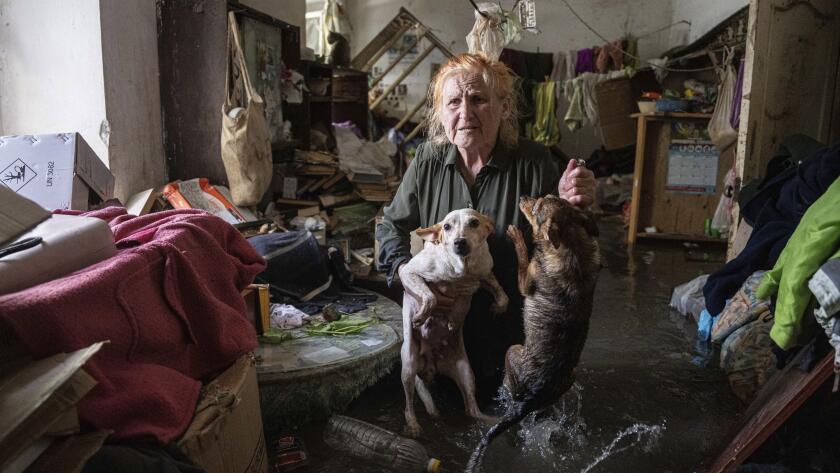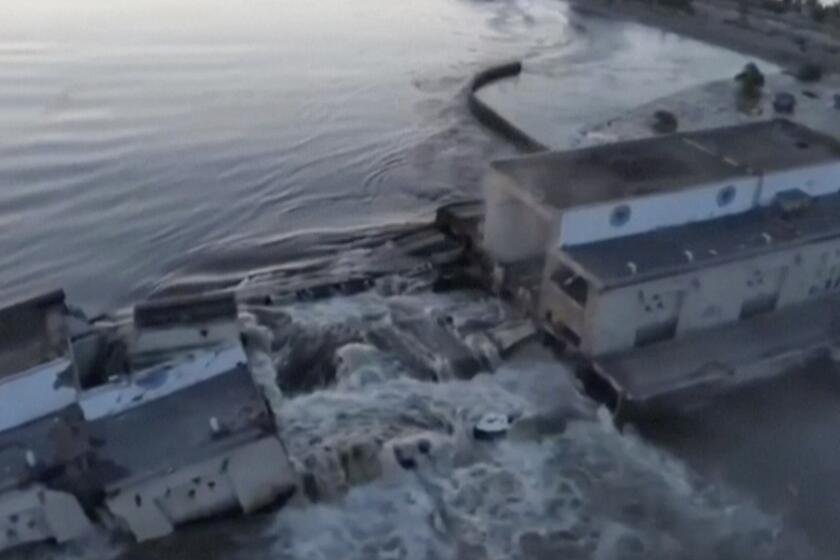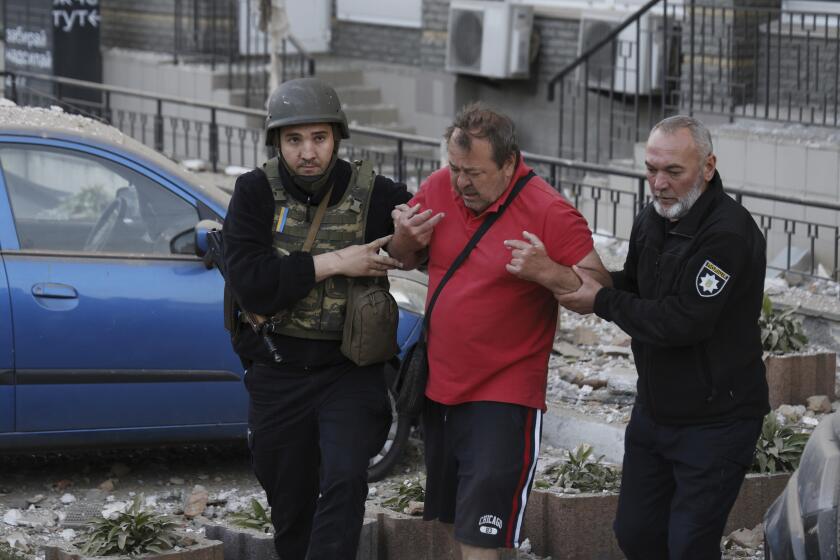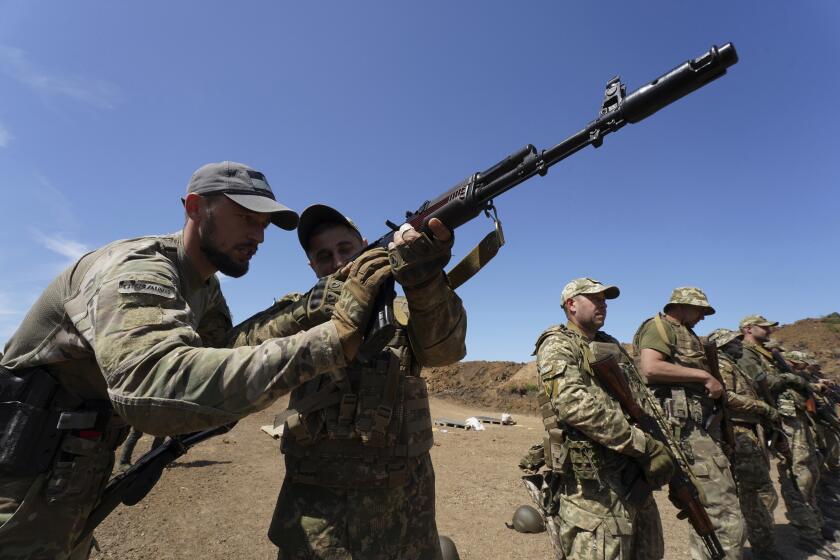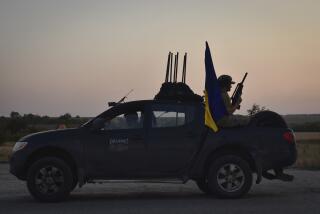Major dam collapse in southern Ukraine floods villages as Moscow and Kyiv trade blame
- Share via
Ukraine says Russian forces blew up a major dam and hydroelectric power station in occupied territory, unleashing a potential ecological disaster.
- Share via
KHERSON, Ukraine — A major dam in southern Ukraine collapsed Tuesday, flooding villages, endangering crops in the country’s breadbasket and threatening drinking water supplies as both sides in the war scrambled to evacuate residents and blamed each other for the destruction.
Ukraine accused Russian forces of blowing up the Kakhovka dam and hydroelectric power station, built in the 1950s on the Dnipro River in an area that Moscow has controlled for more than a year. Russian officials, meanwhile, blamed Ukrainian military strikes in the contested area. It was not possible to verify the claims.
Russian and Ukrainian officials used terms including “ecological disaster” and “terrorist act” to refer to the torrent of water gushing through the broken dam and beginning to empty an upstream reservoir that is one of the world’s largest.
Ukrainian President Volodymyr Zelensky called it “the largest man-made environmental disaster in Europe in decades.” U.N. Secretary-General Antonio Guterres called it “another devastating consequence of the Russian invasion of Ukraine.”
As homes, streets and businesses flooded, authorities expressed concern about supplies of drinking water and emergency crews evacuated thousands of people from both Ukrainian- and Russian-controlled areas.
In the downstream city of Kherson, angry residents cursed as they tried to save their pets and belongings. A woman who gave her name only as Tetyana waded through thigh-deep water to reach her flooded house and rescue her dogs. They were standing on any dry surface they could find, but one pregnant dog was missing. “It’s a nightmare,” Tetyana kept repeating, declining to give her full name.
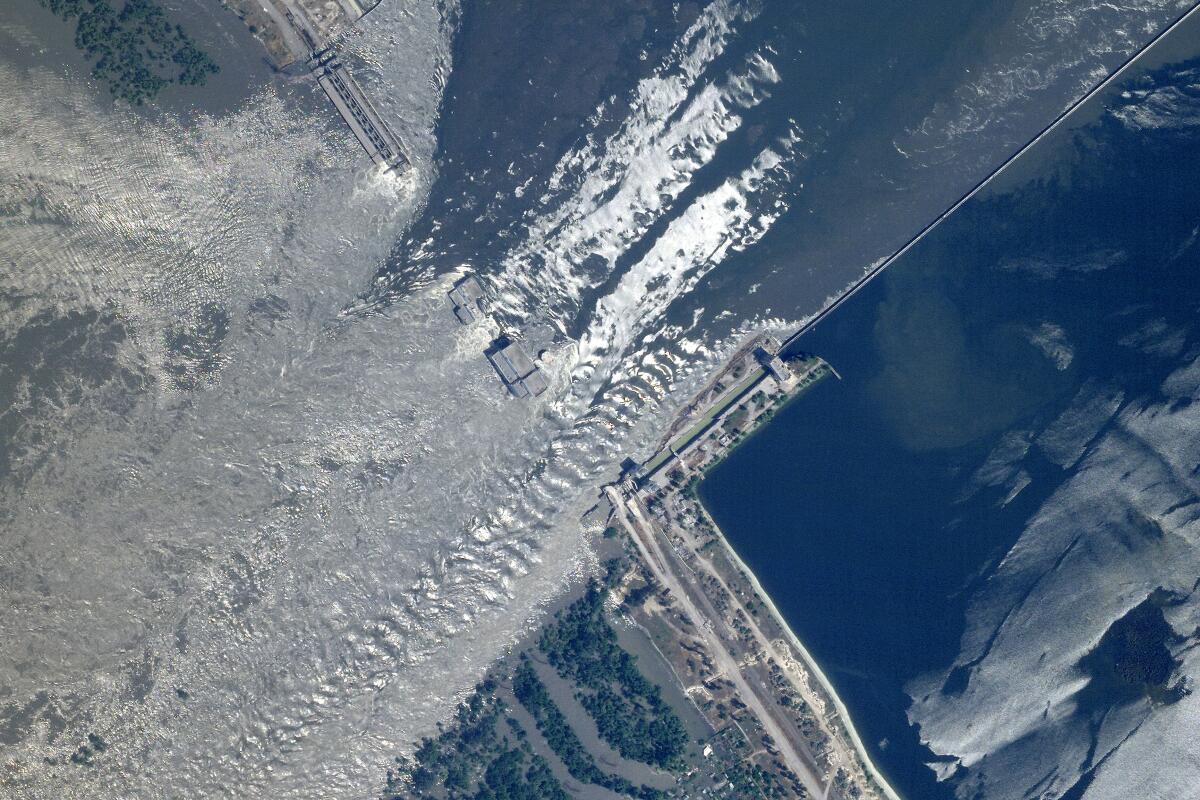
Both Russian and Ukrainian authorities brought in trains and buses for residents. About 25,000 people in Russian-controlled areas and 17,000 in Ukrainian-held territory should be evacuated, Ukraine’s deputy chief prosecutor Viktoriia Lytvynova said on Ukrainian television. Neither side reported any deaths or injuries.
A satellite photo Tuesday morning by Planet Labs analyzed by the Associated Press showed a large portion of the dam’s wall — more than 1,900 feet — missing.
The dam break, long feared by both sides, added a perilous new dimension to Russia’s ongoing war in Ukraine, now in its 16th month, as Ukrainian forces were widely seen to be moving forward with a long-anticipated counteroffensive in patches along more than 600 miles of front line in the east and south of Ukraine.
It was not immediately clear whether either side stood to gain from the damage to the dam, and its collapse might have resulted from gradual degradation. Both Russian-controlled and Ukrainian-held lands are at risk of flooding.
The rupture of the dam that impounds Ukraine’s largest reservoir released a torrent of water, raising fears of widespread damage and flooding.
Russian Defense Minister Sergei Shoigu accused Ukraine of destroying the dam to prevent potential Russian attacks in the Kherson region after what he said was a failed Ukrainian counteroffensive in recent days. He claimed that Ukraine had lost 3,715 troops and 52 tanks since Sunday and, in a rare acknowledgment of Russia’s own losses, said 71 Russian troops had been killed and 210 wounded. Ukraine followed its standard practice of not commenting on its casualties.
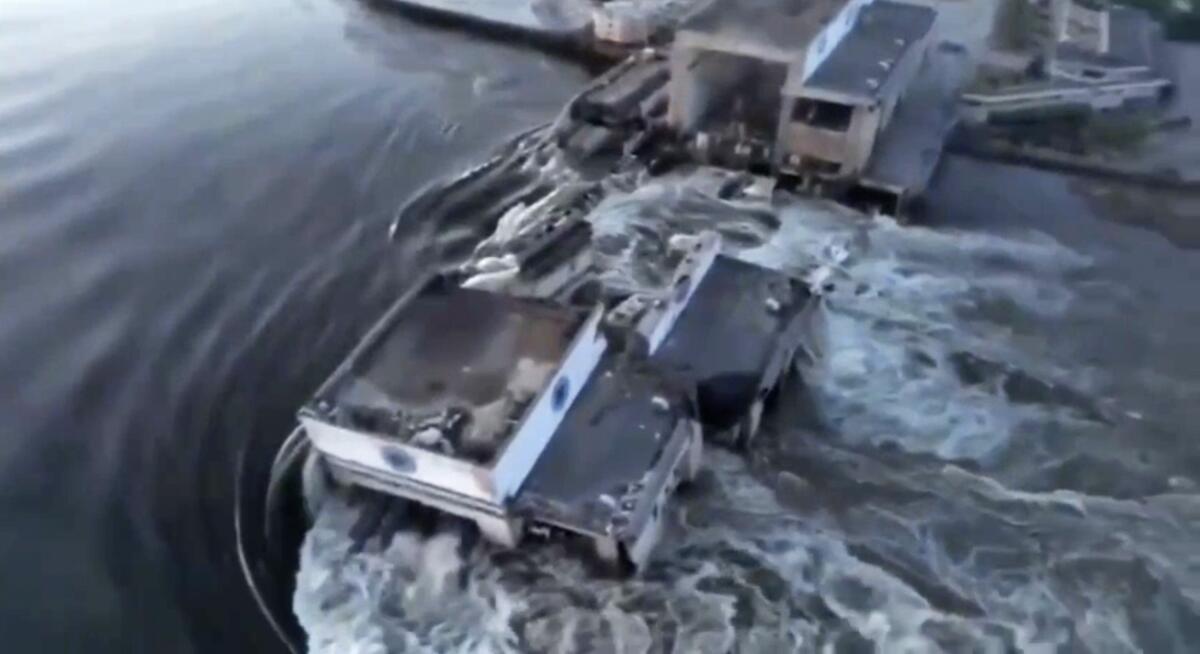
Zelensky told reporters his government had information about Russia mining the dam last year, so “there may come a moment when an explosion occurs.” Other Ukrainian officials alleged that Russia blew up the dam to hamper Kyiv’s counteroffensive, even though observers note that crossing the broad Dnipro River for an assault would be extremely challenging. Other sectors of the front line are more likely avenues of attack for Ukraine, analysts say.
Even so, Nigel Gould-Davies, a senior fellow for Russia and Eurasia at the International Institute for Strategic Studies, called the alleged Russian destruction of the dam “a profoundly defensive measure” that betrayed a “lack of confidence in Russia’s longer-term prospects” in the war.
Experts have previously said the dam structure was suffering from disrepair, which could also have led to the breach. David Helms, a retired U.S. scientist who has monitored the reservoir since the start of the war, said it wasn’t clear whether the damage was deliberate or caused by simple neglect from Russian forces occupying the facility.
But he also noted a Russian history of attacking dams.
Russian officials say their forces have foiled a major Ukrainian assault in two provinces of Ukraine that Moscow illegally annexed in September.
Underscoring the global repercussions, wheat prices jumped 3% on commodities markets after the collapse. Ukraine and Russia are key global suppliers of wheat, barley, sunflower oil and other food to Africa, the Middle East and parts of Asia.
Authorities, experts and residents have expressed concern for months about water flows through — and over — the Kakhovka dam. After heavy rains and snowmelt last month, water rose beyond normal levels, flooding nearby villages. Satellite images showed water washing over damaged sluice gates.
Russian air defenses stopped eight drones converging on Moscow, officials said Tuesday, in an attack that Russian authorities blamed on Ukraine.
Zelensky alleged Russian forces set off a blast inside the dam structure at 2:50 a.m. Tuesday and said about 80 settlements were in danger.
Kremlin spokesman Dmitry Peskov alleged that it was “a deliberate act of sabotage by the Ukrainian side … aimed at cutting water supplies to Crimea.”

White House National Security Council spokesman John F. Kirby told reporters the U.S. “cannot say conclusively what happened” and declined to assess the impact on Ukraine’s counteroffensive.
At an emergency meeting of the U.N. Security Council later in the day, the U.S. deputy ambassador offered no clarity about what Washington sees as the cause of the dam’s collapse, while the Russian and Ukrainian ambassadors traded blame.
Both sides warned of a looming environmental disaster from polluted waters partly caused by oil leaking from the dam’s machinery and farmland deprived of irrigation.
The Ukrainian Interior Ministry called for residents of 10 villages on the river’s right bank and parts of the city of Kherson to gather essential documents and pets, turn off appliances and leave.
U.N. humanitarian chief Martin Griffiths told the Security Council that at least 40 settlements in the Kherson region were already flooded.
Concerns around civilian safety have spiked in Ukraine, as officials announced that an inspection had found nearly a quarter of the country’s air-raid shelters locked or unusable.
The Russian-installed mayor of occupied Nova Kakhovka, Vladimir Leontyev, said the city was being evacuated.
The Zaporizhzhia nuclear power plant, Europe’s biggest, relies in large part on water from the dam’s now-emptying reservoir. The United Nations’ International Atomic Energy Agency said in a statement that there was “no immediate risk to the safety of the plant,” whose six reactors have been shut down for months but still require water for cooling.
It said the rate of the drop in the dam’s reservoir level increased from 2 inches to 3.5 inches an hour and could be depleted in a couple of days. The plant has other sources of water that can last for months, according to the IAEA.
Secretary of State Antony J. Blinken says there can be no cease-fire in Ukraine unless it’s part of a deal that includes Russia’s military withdrawal.
Ukrainian authorities have previously warned that the dam’s failure could unleash a volume of water estimated as nearly equivalent to that of the Great Salt Lake in the United States.
Breaking News
Get breaking news, investigations, analysis and more signature journalism from the Los Angeles Times in your inbox.
You may occasionally receive promotional content from the Los Angeles Times.
Mykhailo Podolyak, a senior advisor to Zelensky, said that “a global ecological disaster is playing out now ... and thousands of animals and ecosystems will be destroyed in the next few hours.”
The incident also drew international outrage, including from German Chancellor Olaf Scholz and North Atlantic Treaty Organization Secretary General Jens Stoltenberg, who said the “outrageous act … demonstrates once again the brutality of Russia’s war in Ukraine.”
Ukraine controls five of the six dams along the Dnipro River, which runs from its northern border with Belarus down to the Black Sea and is crucial for the entire country’s drinking water and power supply and that of Russian-occupied Crimea.
Ukrainian President Volodymyr Zelensky delivered a surprise commencement address via livestream at Johns Hopkins University in Baltimore on Thursday.
Ukraine and Russia have previously accused each other of targeting the dam with attacks.
More to Read
Sign up for Essential California
The most important California stories and recommendations in your inbox every morning.
You may occasionally receive promotional content from the Los Angeles Times.
